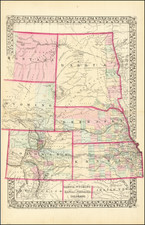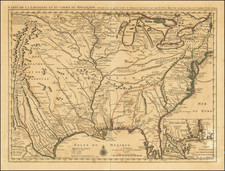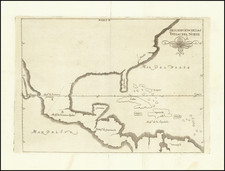Fine watercolor illustration of the La Balise settlement near the mouth of the Mississippi River, with boats and alligators in the foreground, illustrating the expedition of Friedrich Paul Wilhelm up the Mississippi and Missouri Rivers in 1822-1824.
Wilhelm is one of the most important explorers of the Upper Mississippi and Missouri Rivers. On his second expedition to America, Wilhelm would go on to discover the headwaters of the Missouri in 1829. Wilhelm is one of the most important explorers of the Upper Mississippi and Missouri Rivers. On his second expedition to America, Wilhelm would go on to discover the headwaters of the Missouri in 1829. The present sketches would appear to have been constructed either on the spot or from sketch books brought back from the expedition, possibly in preparation for the use as illustrations in Wilhelm's published account of his expedition. The present sketch is one of two acquired in Germany in 2012, the second, St. Charles, Missouri, shows the State Capital of Missouri.
The drawing, which is signed on the verso, illustrates the important town of La Balise at the mouth of the Mississippi River, which was settled shortly after La Salle's visit in 1682. The drawing appears to have formed the basis for a lithographic print of La Balise which accompanied Wilhelm's Reise nach dem nördlichen Amerika in den Jahren 1822 bis 1824 (entitled: Die Balize an der Mündung des Mississippi, Deák, Picturing America 334).
Friedrich Paul Wilhelm, the Fifth Duke of Württemberg, made his first expedition to the United States in years 1822-24, which he described in his diary published in 1835 ( Reise nach dem nördlichen Amerika in den Jahren 1822 bis 1824).
Between the years 1822 to 1824, Paul Wilhelm's undertook his first major research trip to Cuba and North America. His diary described the places he visited in great scientific and ethnological detail. Wilhelm arrived in New Orleans in December 1822. His party took a riverboat up the Mississippi to St. Louis, where the Prince met with the Superintendent of Indian Affairs, William Clark, who granted him a passport into the interior country. Wilhelm was also introduced the son of Sacagawea, Jean Baptiste Charbonneau.
After his initial meeting with Jean Baptiste Charbonneau in 1823 at the Kansas River, Wilhelm left camp and headed north with Great Plains veteran Toussaint Charbonneau, Jean Baptiste's father and Sacagawea's husband, hired as an interpreter. The Duke's party spent five months in the upper Missouri country visiting trading forts, Indian tribes, and collecting scientific data.
In describing La Balise, Wilhelm noted (from the English translation):
The few wooden houses which make up the place stand on piles in the midst of the water and slime, between high reeds; and one house can only be reached from another along plank footpaths.
Regarding the alligator in the foreground, Wilhelm observed that in the warm season " exceedingly large numbers" of them inhabit the banks. "It seems a mystery how these obviously voracious creatures are able to find prey enough to still their hunger."
La Balise, Louisiana, was the first French fort and settlement near the mouth of the Mississippi River. Inhabited by 1699, La Balise was one of the oldest French settlements in modern Louisiana. La Balise was inhabited chiefly by fishermen, river pilots, and their families. The pilots were critical to helping ships navigate to and from the port of New Orleans through the shifting passages, currents and sandbars of the river's delta front. The village was vulnerable to seasonal hurricanes and was regularly damaged or destroyed by hurricanes, the last of which occurred in 1831 and 1846, after which the settlement was relocated to the Southwest Pass.
Duke Friedrich Paul Wilhelm of Württemberg (1797 – 1860 ) was a member of the House of Württemberg and a Duke of Württemberg.
Paul Wilhelm was a German naturalist and explorer, who in the early 19th century, undertook several expeditions in North America, North Africa, and Australia. In 1829, he discovered the sources of the Missouri River.
Between the years 1822 to 1824, Paul Wilhelm's undertook his first major research trip to Cuba and North America. He kept a diary in which he described the places he visited in great scientific and ethnological detail. An artist produced numerous images of the landscapes, plants, and animals.
Paul Wilhelm devoted himself particularly to the study North and South America. He spent time exploring the Western United States and met the son of Sacagawea, Jean Baptiste Charbonneau. After his initial meeting with Jean Baptiste Charbonneau in 1823 at the Kansas River, likely arranged by William Clark, Paul Wilhelm left camp and headed north with Great Plains veteran Toussaint Charbonneau, Jean Baptiste's father and Sacagawea's husband, hired as an interpreter.
The Duke’s party spent five months in the upper Missouri country visiting trading forts, Indian tribes, and collecting scientific data. Paul Wilhelm is traditionally included as one of the first explorers of the headwaters of the Mississippi and Missouri rivers.
As late as the 1850s, he visited Baron Ottmar von Behr, a German farmer and sheep breeder, meteorologist, and scientist living in Sisterdale, Texas. When he visited New Braunfels on an 1855 visit, artist Carl G. von Iwonski made him a gift of six pencil sketches of the artist's Texas work.













![[ French Louisiana ] Carte De la Louisiane par Le Sr. D'Anville Dressee en Mai 1732. Publiee en 1752](https://storage.googleapis.com/raremaps/img/small/88804.jpg)
